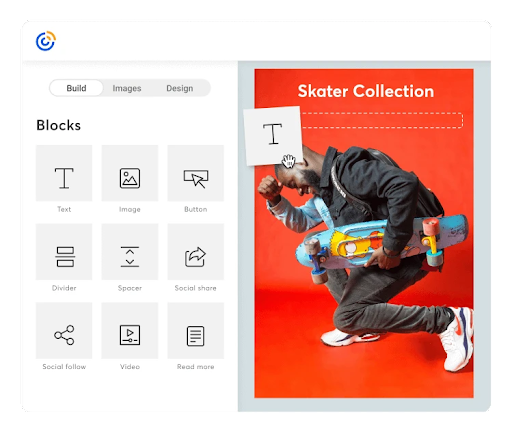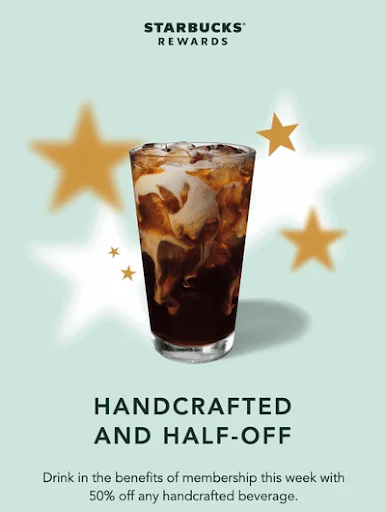
Email marketing is an essential part of any digital marketing strategy. With it, you can reach your target audience, share impactful promotional content, and drive conversions.
Implementing direct email marketing will help you get ahead of your competitors who overlook this powerful marketing method. Learn what direct email marketing is and how to leverage it to grow your business.
Introduction to direct email marketing
What is direct email marketing? Direct email marketing is the practice of sending promotional emails directly to your customers and potential customers. The message goes straight from the business to the target audience, making it a “direct” marketing channel.
What is a direct marketing email?
The content of these marketing emails varies. Some may provide educational content related to the brand’s products or services. Others may introduce new product developments or special deals. Any promotional content businesses send via email to targeted groups of customers is a direct marketing email.
Effectiveness of direct email marketing
Before investing in this marketing strategy, you may ask yourself, “Are direct email marketing campaigns effective?” The simple answer is: Yes, email marketing is incredibly effective.
According to a Litmus report, more than 90% of marketers believe email marketing is important in their company’s success. Email marketing provides an excellent return on investment (ROI), averaging $36 for every $1 spent. That’s a 3,600% return. Very few other marketing channels are as cost-effective as email marketing.
Direct email marketing is not without its drawbacks, however. For example, companies using direct email marketing may run into issues with spam filters that prevent their emails from reaching customers. Designing and writing effective marketing emails is also challenging, especially for brands venturing into email marketing for the first time.
Luckily, none of these challenges are insurmountable. With the right strategy and direct email marketing solution, you can make this channel work wonders for your business.
Creating a strategy
Getting started is the hardest part of email marketing. Step one is to develop your strategy. To create a successful direct email marketing strategy:
- Determine your goals: The most effective strategy is tailored to your brand’s specific goals. Do you want to increase brand awareness? Increase your upselling and cross-selling? Improve your customer retention? Your goals will inform your email marketing practices.
- Build your email list: You need a strong email list to reach the right people with your email promotions. This list is full of customers and potential customers who have already agreed to receive emails from your business.
- Segment your customers: One of the main strengths of email marketing is that it allows you to easily segment your customers into smaller groups by shared characteristics. For example, you can create a segment of customers who have spent $500+ on your products and send them a thank-you email to recognize them.
Four types of email marketing messages
Your strategy depends on the type of email marketing you plan to use. What are the four types of email marketing? They cover several key areas:
- Transactional emails: Confirm customer purchases
- Promotional emails: Keep customers aware of your special deals and discounts
- Email newsletters: Build brand awareness with updates and other engaging information
- Retention emails: Help you engage and keep existing customers
Key direct email marketing metrics
Tracking and evaluating metrics is a key part of any marketing strategy. These metrics will tell you what’s working and what you can improve in your campaigns. Here’s how to measure direct email marketing success with key metrics:
- Open rate: Your open rate is the percentage of all recipients who open your email. You want this percentage to be as high as possible. One way to increase your open rate is to write more compelling subject lines.
- Click-through rate: The click-through rate (CTR) on your marketing email is the percentage of recipients who click on a link in the message. If you send 1,000 emails and 100 people open a link in those emails, your CTR for that email is 10%.
- Bounce rate: The bounce is the percentage of emails you send that do not reach the recipient’s inbox. Emails can bounce for several reasons, such as invalid recipient email addresses, full inboxes, or spam filters. Watch your bounce rate for any unusual spikes that may indicate an issue with your emails.
- Conversion rate: The conversion rate on your emails is the percentage of messages that result in a customer completing a desired action, like making a purchase. Divide the number of customers who completed this action by the total emails you sent to get your conversion rate.
- Email list growth: Hopefully, you will continue to grow your email list over time so you can reach more and more customers. Track your email list numbers to know if the growth slows or even stops. A welcome email and email retargeting can help keep your list numbers up over time.
Direct email marketing best practices
If you’re not careful, it’s easy to make costly mistakes in your promotional emails. Keep these do’s and don’ts of effective email marketing in mind:
Do: Personalize your emails
Email is a marketing channel that allows you to personalize your messages easily. Try to incorporate a personalized greeting for each customer, make personalized recommendations for each customer, and reference previous interactions they’ve had with your brand when possible. Direct email marketing services like Constant Contact include convenient tools to help with this personalization.
Don’t: Leave out a call-to-action (CTA) in each email
You should have a clear goal of what customers should do after reading each email you send. Take that desired behavior and create a corresponding call to action that prompts the reader to take the next step. The CTA should be large, distinct, and easy to click so the readers don’t miss it.
Do: Use an email builder for better email design
It’s tricky to get your email design right when you do it manually, but an email builder can help you create stunning messages with ease. Direct email marketing companies like Constant Contact offer tools like pre-designed email templates for simpler email creation. You can drag and drop email components like text, images, and buttons in Constant Contact’s email editor to have a professional email ready in moments.

Don’t: Forget to proofread your messages
There’s nothing more unprofessional and offputting to customers than a brand email with errors. Proofread each email until you’re sure there are no typos or other mistakes in your message. Run the message through an online grammar checker to be safe.
Do: Write a compelling subject line
When an email arrives in a customer’s inbox, they use two main pieces of information to decide whether to open it: the email sender and the subject line. The stronger your subject line is, the better the odds are your recipients will open and engage with it. Think about the best subject lines that would entice your target customers to open your message.
Avoid “click-bait” phrases that mislead the audience and focus on catching their attention honestly.
Don’t: Forget to follow through or be inconsistent
Follow-throughs ensure you don’t leave any leads hanging and keep customer interest over time.
You also want to ensure consistency — in the timing and delivery, style, voice, and all other areas of your email. This way, readers know what to expect and won’t be confused by varying styles.
Targeting and segmentation
Part of any great direct email marketing strategy is a focus on audience segmentation and targeting. Audience segmenting is all about breaking down your customers into smaller groups based on common attributes. For example, you may segment your audience by location if customers in different areas have distinct needs and preferences. Segmenting by age and gender is very common.
Segmenting allows you to create email messages that are more tailored to the recipients rather than sending the same message to everyone. Another example of segmenting in email marketing is separating your email list into prospective and existing customers. That way, you can create specific messages for returning customers and different messages to entice new customers.
Segmenting and targeting work best when you have a large audience. Follow these creative ways to grow your email list so you have plenty of people to email. As your list grows and you have more interested customers to contact, you increase your odds of making conversions.
Email testing
Don’t expect the first version of every strategy and message to be perfect. Email marketing requires testing and monitoring for continuous improvement. For instance, run A/B tests and send out two similar but distinct versions of the same email in small batches. Comparing the performance of these two emails will help you determine what works best with your audience, and you can proceed with the better email.
Goals and stages of direct email marketing
Brands use email marketing to accomplish many different goals. What is the direct mail method of marketing? Some of the main goals of direct email marketing include:
- Increasing brand awareness
- Generating and nurturing leads
- Driving web traffic
- Retaining customers
- Increasing sales
- Creating upsell and cross-sell opportunities
- Building brand loyalty
Develop an email marketing strategy tailored to your business goals. For example, if you want to create cross-sell opportunities, segment your customers by their previous purchases and send emails recommending complementary products. Send special offers to individuals to drive sales and engagement.
You don’t have to choose just one goal to focus on, but understanding your goals can help you focus your efforts.
Performance measures and examples
The best email marketing campaigns don’t just deliver a strong open rate or click-through rate — they deliver tangible results that help your business grow. Design your emails to drive conversions and sales.
You may be wondering: What is a direct email with an example? Use these case studies of the best direct email marketing examples for inspiration.
Beardbrand
To reengage customers and get them interested in new products, Beardbrand sent an email with the latest best sellers. The call-to-action in this message, “check out what I’ve missed,” is especially strong since it plays on the reader’s fear of missing out on something great. Bright, clear product images help to engage the audience further.

Starbucks
Starbucks shared this promotional email exclusively with members to alert them to a special deal available that week. It’s simple but effective, with colorful graphics and a straightforward call to action.

Additional considerations
Some additional considerations to consider while implementing email marketing include:
Email marketing and customer service solutions
Email marketing goes hand-in-hand with customer relationship management. With that in mind, you may want to integrate your email marketing efforts with your CRM. Combining the two will strengthen both. For example, you can use data like customer purchase history from your CRM to better customize your email messages. Direct email marketing tools can make this process a breeze.
You’ll also want to use an omnichannel strategy and ensure consistent messaging across all channels so consumers see you as a cohesive brand.
Avoiding email marketing pitfalls: honeypots and spam traps
The better your email delivery, the more effective your email marketing campaigns will be. So, what is email deliverability? Email deliverability is the percentage of your messages reaching your intended recipients. This goes down significantly if you get caught in spam traps. Follow email best practices to avoid getting caught in honeypots — decoy email addresses meant to catch spammers — and other spam traps.
Conclusion and further learning
Direct email marketing is a powerful tool for any business, especially with the help of the right email direct marketing tool. Use email marketing to connect with your target audience, segment your customers into groups, and send personalized promotional messages that convert. Learn more about generating email leads and upholding legal and ethical standards in your marketing campaigns before you get started. And keep in mind that email marketing, like digital marketing overall, is constantly evolving. In the future, brands will likely emphasize artificial intelligence (AI) and direct email marketing software even more to help them with their campaigns. To stay competitive, you’ll need to combine email marketing best practices with the strongest tools and resources available. Get started today with a free trial of Constant Contact.





